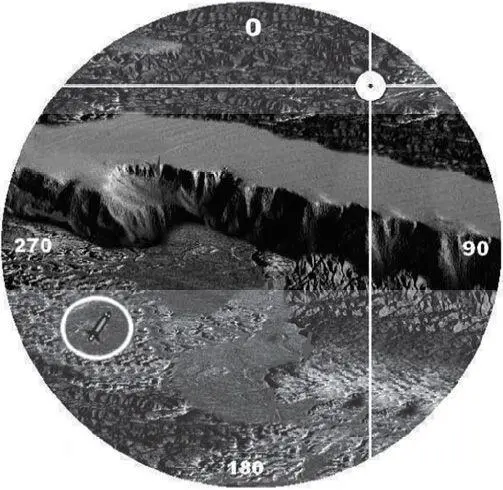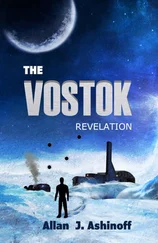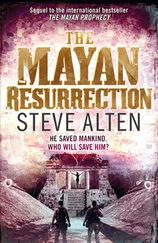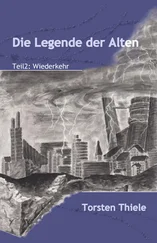A black-and-white photo pixilated across our computer screens. The image was generated from sensory equipment aboard Onyx and Lacrosse , a series of terrestrial reconnaissance satellites launched into orbit thirty years ago and only recently declassified. The satellites were equipped with synthetic aperture radar and other sophisticated instruments designed to see through cloud cover, ocean, ice, and even soil.
The Onyx satellite had pinpointed our sub by our lasers’ heat signature. The SAR unit had generated the view of Vostok’s topography.

“Captain, we suggest you set a course on heading zero-three-seven. If you average twenty knots, you should reach the extraction point in less than five hours. That will give your team nine hours to collect water samples and explore Vostok before you need to start your ascent.”
“Roger that, Lopez.” Ben brought the sub about until we were pointed on our northeasterly heading, cruising along the surface at twenty knots.
I laid my head back, staring at endless mist as we plowed through perpetual darkness. I could have used my nocturnal glasses, but there was nothing to see. We had just pulled off an incredible engineering feat, gaining access to a lost world preserved beneath fifteen million years of ice, and yet somehow I felt disappointed.
What had I expected? What would have made me happy? Traces of fecal matter from a prehistoric trout? Perhaps a fossil or two?
One thing is for sure: we weren’t about to find anything along the surface.
“Ben, any objections to checking out the bottom?”
“What for?”
“Maybe we can find some fossils.”
Ming raised her head from her computer. “Yes. Very good, Zachary. I wanted to collect silt samples anyway.”
“You two do realize the depths in this basin exceed twenty-five hundred feet?”
“It is a submersible,” I said, winking at Ming. “You’re allowed to get it wet.”
“Suddenly the Sargasso survivor is a daredevil? Okay, Doc. As my tenth-grade English teacher said to me before she popped my cherry, ‘Hold on, kid, I’m goin’ down.’”
I grabbed onto the padded leather support handles as the bow dropped away into a near-vertical descent, the depth gauge’s numbers advancing rapidly.
Four hundred feet…
Seven hundred feet…
“Easy, Captain, there’s no rush.”
“What’s wrong, Doc? I thought you were an adrenaline junkie.”
One thousand feet…
At 1,340 feet I felt the hull groan, the acrylic emergency pod wobbling under the sudden wave of pressure.
Ming reached forward and gripped the pilot’s right arm. “Slow it down or Zachary will pilot the sub and you can catch the next cargo plane back to Wisconsin.”
Ben eased up on the throttle, altering our angle of descent. “No worries. I was just seeing what this vessel could handle. That’s standard operating procedure on a maiden voyage — part of my job.”
“And part of my job is to minimize the risks to the crew. Zachary, are you all right?”
Ugh . “Fine, thank you, Ming.” Yes. Thank you, Ming, for emasculating me in your penis-shaped submersible. And thank you for hiring an ego-driven headcase who managed to get himself kicked out of the Air Force for mistakenly entering a sovereign nation’s air space. And thank you, Angus, for once again screwing up my life .
As we passed two thousand feet, Ming squealed something in Chinese. “Zachary, I just took another water sample. The temperature has dropped to minus sixteen degrees Fahrenheit, with total dissolved solids exceeding two thousand miligrams.”
I turned to face her. “We’re entering a hypersaline chemocline. Vostok is a mineral concentrator. Remember, it’s connected to Antarctica’s oceans by a subglacial river. Residual salts have become trapped over millions of years, concentrated along the bottom. Lake Bonney works the same way; it has a temperature of minus twenty-three. Don Juan Pond is liquid at minus twenty-two. I wouldn’t be shocked to find weird microbial communities thriving down here.”
Geez, Wallace, you are such a nerd .
The tea-colored waters in our headlights grew more turbid as we descended, and the current increased, forcing Ben to decrease his angle of descent.
By the time we reached 2,185 feet, the Barracuda had nearly leveled off, the depths sweeping us north in the belly of a seventeen-knot current.
Ming aimed her keel light at the bottom, her underwater camera revealing a smooth, gray bedrock lake floor littered with fossils.
“Captain, slow down. I want to take a look. I want to collect samples.”
“In this current?”
I shook my head. “Just come about and put our bow into the current. Haven’t you ever changed a sail before?”
“Not in a sub, smart-ass.”
Ben executed a bone-jarring turn, the current buffeting our craft until our bow was pointing south, our propulsors neutralizing the force of the water. Maintaining a forward speed of twenty knots, we cruised slowly over the ancient bottom, the treasures of the long-lost Miocene era appearing on our video screen.
For the next half an hour, we worked our way over unrecognizeable shards of bone and rock that were hardly worth the journey — until the remains of an ancient water creature blanched white in our keel lights.
Its backbone stretched before our widening eyes, each form-fitted vertebra as large as a bowling ball. I estimated the spine to be forty feet long, and then I saw the size of its skull and the adrenaline started pumping.
In November of 2008, paleontologists excavating a dried lake bed in Peru had stumbled across the fossilized remains of an undiscovered sea monster that definitely ranked up there as one of Nature’s all-time killers. From the partially preserved skull, teeth, and mandible, they knew the creature had been enormous, as long as sixty feet. The cranium’s curved basin suggested it harbored a spermaceti organ — a series of oil and wax reservoirs separated by connective tissue, theorized to be a resonance chamber used by cetaceans for echolocation.
The owner appeared to be the ancestor of a sperm whale, with one major anatomical difference — the Miocene killer had possessed a lower jaw that was far wider than that of its modern-day cousin, giving it a bite that rivaled Carcharodon megalodon , its chief competitor.
After much debate the excited researchers settled on a name for their mammalian monster: Livyatan melvillei , combining the Hebrew spelling for the biblical Leviathan with the surname of Herman Melville, the author of Moby Dick . It was a fitting title for an ocean predator that had not only owned one of the most vicious bites in history but also the largest teeth, some of which measured fifteen inches.
I had no doubt that the skull and jawbone lying twelve feet beneath our keel belonged to this Miocene monster. But why had these ocean-dwelling whales entered Vostok? Had something enticed them to venture upriver into a saltwater lake? Was it a survival instinct, a search for prey… or something else entirely?
The teeth were enormous, cone-shaped, and twice as long as an ear of corn. Ming quickly located a tooth that had belonged to the beast’s lower jaw and decided she could acquire it using the sub’s claw.
Ben disagreed. “The current will snap the claw like kindling.”
“Nonsense. It will hold.”
“It’s too risky. If it bends you won’t be able to dock the arm. And if you can’t dock it, it will interfere with our ascent. Tell her, Zach.”
Читать дальше













